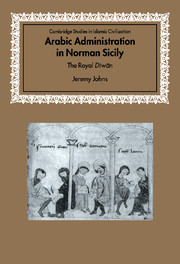Book contents
- Frontmatter
- Contents
- Preface
- Tables
- Abbreviations
- Genealogical table of the De Hautevilles of Sicily
- Note on Measurements
- Introduction
- 1 ‘In the time of the Saracens …’
- 2 ‘When first the Normans crossed into Sicily …’
- 3 ‘Our lady, the Regent Adelaide, and our Lord, the Count Roger, her son’, 1101–30
- 4 The earliest products of the royal dīwān, 1130–43
- 5 The jarāʾid renewed, 1144–5
- 6 The records of the royal dīwān. Part I: the jarāʾid al-rijāl
- 7 The records of the royal dīwān. Part II: the dafātir al-ḥudūd
- 8 The duties and organisation of the royal dīwān, 1141–94
- 9 ‘The people of his state’. The ‘palace Saracens’ and the royal dīwān
- 10 The Norman dīwān and Fāṭimid Egypt
- 11 Royal dīwān and royal image
- Appendix 1 Catalogue of dīwānī documents
- Appendix 2 Provisional catalogue of private documents
- Appendix 3 Abū Tillīs – ‘Old Wheat-sack’
- List of References
- Index
- Titles in the series
8 - The duties and organisation of the royal dīwān, 1141–94
Published online by Cambridge University Press: 10 March 2010
- Frontmatter
- Contents
- Preface
- Tables
- Abbreviations
- Genealogical table of the De Hautevilles of Sicily
- Note on Measurements
- Introduction
- 1 ‘In the time of the Saracens …’
- 2 ‘When first the Normans crossed into Sicily …’
- 3 ‘Our lady, the Regent Adelaide, and our Lord, the Count Roger, her son’, 1101–30
- 4 The earliest products of the royal dīwān, 1130–43
- 5 The jarāʾid renewed, 1144–5
- 6 The records of the royal dīwān. Part I: the jarāʾid al-rijāl
- 7 The records of the royal dīwān. Part II: the dafātir al-ḥudūd
- 8 The duties and organisation of the royal dīwān, 1141–94
- 9 ‘The people of his state’. The ‘palace Saracens’ and the royal dīwān
- 10 The Norman dīwān and Fāṭimid Egypt
- 11 Royal dīwān and royal image
- Appendix 1 Catalogue of dīwānī documents
- Appendix 2 Provisional catalogue of private documents
- Appendix 3 Abū Tillīs – ‘Old Wheat-sack’
- List of References
- Index
- Titles in the series
Summary
Introduction
This review of the duties and the organisation of the royal dīwān is almost exclusively concerned with the Arabic administration, to the exclusion of the Greek and the Latin; with al-dīwān, not ἡ δουάνα (ē douana), nor the duana. As the very existence of these Greek and Latin terms indicates, this is a wholly artificial distinction, but a review of the entire administration of Norman Sicily lies beyond the scope of this work. It would, moreover, largely retrace the steps so recently taken by Hiroshi Takayama in his study of the administration of the Norman kingdom; and would do so without a significant corpus of new evidence yet being available. Although he and I may not always agree upon every twist and turn of that tortuous, and often still obscure path, our destination is essentially the same. Indeed, without Takayama's clear perception of the regional variations between the different provinces of the kingdom, it would have been impossible for me to focus so closely upon the Arabic administration of the island of Sicily, ignoring the mainland provinces of the duchy of Apulia, the principality of Capua, and – to a lesser extent – Calabria. Again, Takayama's vision of a flexible, omnicompetent administration, cuts the Gordian knot so tightly tied by generations of administrative and constitutional historians determined to identify a rigid organisational structure that might be compared to the English exchequer. It also makes room for a study such as this, which concentrates upon only one part of the loose and changeable whole.
- Type
- Chapter
- Information
- Arabic Administration in Norman SicilyThe Royal Diwan, pp. 193 - 211Publisher: Cambridge University PressPrint publication year: 2002

